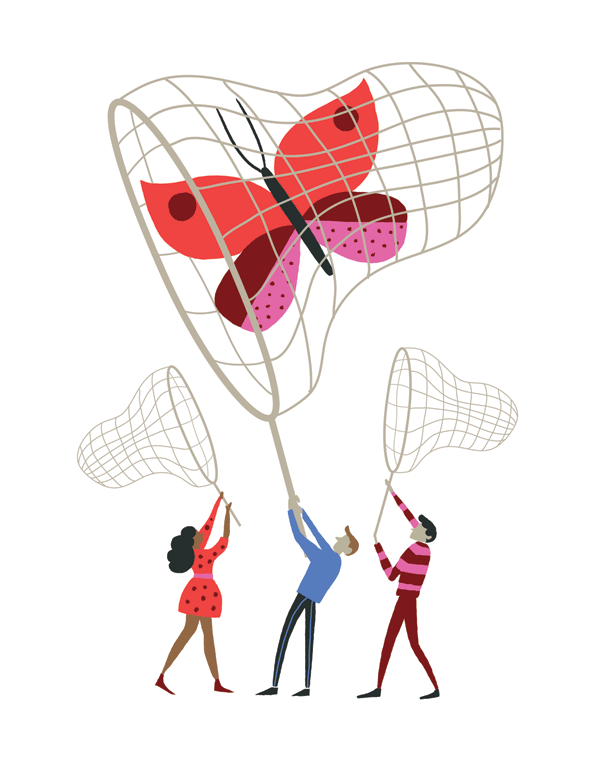Best Business Books 2017: Strategy
Animal Spirits
Leonard Sherman
If You’re in a Dogfight, Become a Cat: Strategies for Long-Term Growth (Columbia Business School Publishing, 2017)
*A TOP SHELF PICK
Olivia Fox Cabane and Judah Pollack
The Net and the Butterfly: The Art and Practice of Breakthrough Thinking (Portfolio/Penguin, 2017)
Heidi K. Gardner
Smart Collaboration: How Professionals and Their Firms Succeed by Breaking Down Silos (Harvard Business Review Press, 2017)
In the business world, conventional wisdom holds that market leaders eventually succumb to the law of large numbers, the law of competition, and the law of competitive advantage. But in the most compelling business book on strategy this year, If You’re in a Dogfight, Become a Cat: Strategies for Long-Term Growth, Leonard Sherman assembles a convincing brief that the slowdowns companies face as they become successful and attract imitators are not inevitable.
A faculty member at Columbia Business School and a career consultant, Sherman builds a persuasive case that it’s possible to achieve and sustain the great desideratum of business: long-term profitable growth. And he does so by telling many fascinating stories of companies that found — and haven’t yet lost — the holy grail, among them JetBlue, Southwest Airlines, IKEA, and, inevitably, Apple.
Sherman argues that companies have to reimagine what they are and thus what they are capable of — hence the dog/cat imagery. He writes that “most companies [pursue] predictable…strategies within well-established business boundaries,” which over time “leads to a blurring of meaningful differentiation between companies competing on the same terms for the same customers.” Instead of by running faster, you “break away from the pack by redefining one or more of the boundaries that historically constrained industry behaviors” and by consistently renewing your product and service portfolios.
Like a skilled arborist, Sherman prunes back the ungainly, overgrown tree that strategy has become since it entered the corporate mainstream in the middle of the last century. He saws off a number of dead branches, including the many prescriptions that emerged from the countless searches for excellence, greatness, and the secrets of success. What’s left behind is an expertly trimmed tree of knowledge that brilliantly summarizes and integrates what’s been learned about strategy over the last 60 years.
The many success stories in this book tell us that the key to sustained, profitable growth is an innovative idea that solves an important problem with a novel solution. For example, the Ford Motor Company went from being just another carmaker in 1910 to being the market leader in 1920, with a 60 percent market share. As Sherman points out, Ford’s strategy of “democratizing the automobile” with one model (the Model T) and one color (black) made on a moving assembly line and sold through third-party dealerships was a very big idea at a time when the market for the horseless carriage was limited to the wealthy.
In fact, having a big idea explains every success Sherman identifies, including Cirque du Soleil (staging a circus without animals), Costco (selling bulk packaged goods, but to members only), Netflix (renting movies by monthly subscription), Southwest Airlines (competing with bus, auto, and train travel), Swatch (positioning watches as timely, affordable fashion accessories), CrossFit (creating gyms for elite athletes), and IBM (serving as your corporate/IT partner). Each of these companies created strategies that enabled it to turn its big ideas into long-term profitable growth. And their growth will eventually stall if those ideas are widely copied or made obsolete, and are not replaced with new ones. This is why Ford is once again just another car company: Every automaker in the world has copied its once-innovative business model, and Ford has yet to create another idea that is big enough (sorry, but an electronic liftgate on the back of an SUV doesn’t qualify!) to fuel profitable, breakaway growth.
Sherman offers an interesting list of reasons that “continuous disruptive renewal” remains the exception, rather than the rule. Essentially, he writes, companies are like dogs, especially older ones: They are easily distracted, are prone to foibles, and find new tricks difficult to learn. They focus on customers and competitors, they have resource constraints, and they suffer from misplaced pride and overconfidence. But the real issue at most companies is the tendency for leaders to overdelegate the job of innovation and strategic renewal. This is why companies are so prone to what Sherman calls feature replication and performance augmentation. These approaches are often the best that middle managers can come up with when leaders abdicate innovation. The crucial difference at companies such as Apple (at least under Steve Jobs) and Amazon is the active, everyday involvement of their CEO in leading and pushing for breakthrough strategic innovation, not just renewing the company’s current products and services, or how it makes, sells, and delivers them.
I do have some problems with parts of Sherman’s argument. In a chapter entitled “There’s No Such Thing as a Bad Industry,” he argues that being average dooms you to poor profitability. But of course, there are plenty of “bad industries.” The author himself gives us two great examples: wine and airlines. In addition, the chapter “Why Are We in Business?” is a misleading lecture based on several untruths and an obviously biased selection of facts — the reader can skip it entirely without losing any of the book’s fine benefits. And the chapter “Where Do Great Ideas Come From?” suggests that they come from modern frameworks and methodologies, though none of these explain where the ideas behind the strategy successes in his book actually came from.
On the whole, however, Dogfight is full of insights, and Sherman argues convincingly that it’s possible to find meaningful differentiation in any industry. He shrewdly notes that too many boards lack sufficient understanding of their company’s strategy and that too many leaders conflate budgeting with planning. But the book’s most important contribution is the marriage of strategy and innovation. Sherman rightly makes the case that if you want to avoid dogfights and become a cat, the latter is central to renewing the former.
Butterfly Effect
How do you make your company better at innovation? You might start by reading The Net and the Butterfly: The Art and Practice of Breakthrough Thinking. The subtitle notwithstanding, the book is really about the science and practice of how we can use our inherent creativity to generate new ideas. The authors — Olivia Fox Cabane and Judah Pollack, who worked at Stanford University’s StartX program — use our latest understanding of brain biology to describe how breakthrough thinking actually happens, and how to make it happen when you need it. “Breakthroughs, like butterflies, may fly an unpredictable path, but it is possible to capture them if we build the right net,” they write.
As Dogfight does, The Net and the Butterfly provides many fascinating examples of iconic innovations, such as the original “eureka” moment experienced by Archimedes, the inspiration that led to round-shot ammunition, the lock-stitch sewing machine, the Wright brothers’ wing-warping breakthrough, the opening riff for the Rolling Stones’ “Satisfaction,” Velcro, pacemakers, Teflon, and, yes, Ford’s moving assembly line. How these inventions came about had little to do with design thinking, disruptive innovation, blue oceans, or any of the other methodologies offered up by consulting firms, innovation gurus, and business school faculty. It had everything to do with the structure and behavior of our brains, say the authors.
Every great strategy stands on the shoulders of a big idea that solves an important problem with a novel solution.
In place of the now-disproved analytical left brain/creative right brain theory, the authors give us EN/DN. Our executive network (EN) is goal oriented and action oriented. We use it when we are focused on tasks, and on using our expertise to solve problems we’ve seen before. The default network (DN) is our meandering mode of thinking, during which we are most able and likely to make new connections between the seemingly unconnected (the authors’ examples include termite towers inspiring self-cooling buildings and bakeries’ conveyor belts inspiring Ford’s moving assembly line). The EN provides the analytical focus to define the problem, and the DN provides the “associative, nonlinear” thinking that is essential to sparking a creative solution to the problem.
Oscillating between the EN and the DN is what enables us to generate breakthrough ideas. This explains the research that tells us creativity is enhanced by alternating between cognitively challenging work and activities with low cognitive load, such as riding a bike. It explains why when I ask executives where they get their best ideas, I never hear “at my desk” or “in a brainstorming session.” The number one answer is “in the shower.” In fact, the authors tell us, the best activity for creativity is walking. This seems to be the single common habit of great innovators in all, ahem, walks of life, including Charles Dickens, Beethoven, Tchaikovsky, Immanuel Kant, Werner Heisenberg, and Steve Jobs.
Citing neuroscience, the authors build a compelling argument that anyone can become more creative. And they provide powerful prescriptions and an enormous toolbox to help readers do just that. For example, your DN is most active when you are falling asleep and waking up. These times are called, respectively, the hypnagogic and hypnopompic states of semi-consciousness, and you can practice inducing yourself into them. Other tips in the book include how to get the most from brainstorming and how to feed your DN with an ever-richer body of facts, stories, knowledge, and experiences. Visual thinking and practicing the “relaxation response” to calm the parasympathetic nervous system are just a subset of the many techniques sprinkled throughout and then helpfully consolidated into an appendix.
Most of the book’s second half is devoted to what Fox Cabane and Pollack believe are the three great killers of creativity: the fear of failure, the experience of failure, and the pain of uncertainty. Most companies, the authors argue, would see a measurable increase in innovation just by increasing their employees’ ability to cope with and manage the real anxiety and actual pain they feel in connection with the prospect and experience of both failure and uncertainty. The authors dispense with the usual clichés about embracing failure and uncertainty, and instead proffer more practical advice — such as reframing, detaching, naming, personifying your inner critic, practicing responsibility transfer, and “loading your certainty bucket.”
Despite its dead-serious content and at times scientific language, the book is an easy read with a good sense of humor. And is it well organized for those who don’t have time to read every word, with key takeaways at the end of each chapter and two appendixes at the end of the book, one on exercises and another on science.
Working Together
Collaboration is a too frequently overlooked practice of successful companies. Without it, strategy, innovation, and execution have little hope. That becomes abundantly clear when reading Smart Collaboration: How Professionals and Their Firms Succeed by Breaking Down Silos, by Heidi K. Gardner.
A fellow at Harvard Law School, previously a faculty member at Harvard Business School, and before that a consultant at McKinsey & Company, Gardner has conducted deep research into law practices, consultancies, accountancies, and engineering firms. But her conclusions apply to any company in which specialized expertise is paramount and complex challenges cross internal boundaries — which is to say, every company.
It turns out that smart — defined as efficient and effective — collaboration pays off, and that can be proved. For the market-facing parts of your business, Gardner argues, the payoff comes in the form of more insight into your customers’ needs and priorities, more differentiated products and services, fewer chances of selling or fulfillment mishaps, and greater numbers of loyal alumni who will send business your way. Smart Collaboration really comes alive in the final chapter, which covers the top 11 reasons customers like it when you are a smart collaborator. My favorite: If customers see that you can collaborate well internally, they’ll assume that you’ll be a great collaborator with them. Another good one: Customers hate cross-selling; great collaborators bring bigger, better solutions, not a bigger menu.
From a talent perspective, Gardner powerfully demonstrates through her extensive research — 10 years of data on eight firms — that smarter collaboration creates more committed, motivated, knowledgeable, confident, trusting, and innovative staff. It also leads to fewer whole-group defections, lower individual attrition, and fewer burnouts. The result is greater staff productivity and lower costs of attracting, on-boarding, integrating, developing, and retaining staff.
Smart collaboration has some daunting barriers. These include insufficient levels of trust and confidence, inadequate knowledge of the company’s capabilities and offerings, and the high costs of coordinating across geographies, generations, cultures, functions, and sectors. Gardner shows us not only how to build a business case for investing in smart collaboration, but also how to get it. Her suggestions include setting up knowledge contests, establishing customer councils, implementing customer laddering (assigning different members of your firm to different staff in your customer’s organization), holding virtual tours for distant colleagues, having internal brokers to clear the internal market for demand and supply of expertise, and holding visible celebrations of collaboration successes.
Several chapters are devoted to how to help particular types of staff — the “solo experts,” the “seasoned collaborators,” the “rainmakers” — use collaboration to grow professionally and build a bigger book of business, responsibilities, or followers. But Gardner’s wisdom is most evident when talking about compensation. In a spot-on section, she writes that companies should measure inputs, not just outputs, to reinforce the behavior they want; avoid individualistic and time-based metrics; prioritize intrinsic motivators (such as recognition and development) over extrinsic motivators (money); have a single profit pool; and use frameworks and guidance, not formulas, to determine pay. Above all, ensure that your compensation system doesn’t harm your company’s ability to simultaneously collaborate and hold itself accountable.
This is a timely book because the demand for specialization and the complexity of making companies more than just the sum of their parts will only grow. In a world of dog-eat-dog competition where markets move in the unpredictable pattern of butterflies, it helps to remember Benjamin Franklin’s famous maxim: “We must, indeed, all hang together, or most assuredly we shall all hang separately.”
Reprint No. 17410
Author profile:
- Ken Favaro is a contributing editor of strategy+business and the lead principal of act2, which provides independent counsel to executive leaders, teams, and boards.








